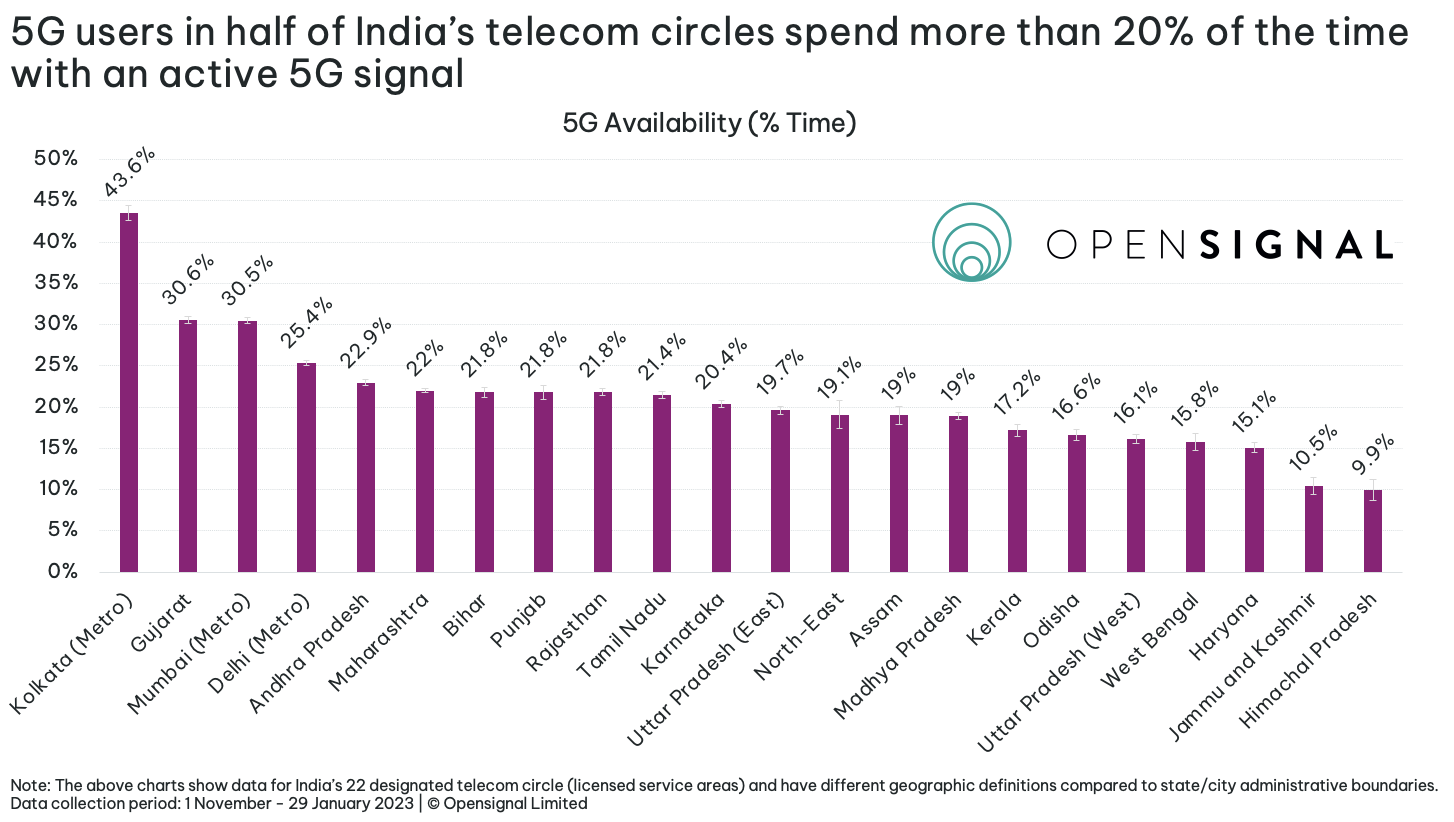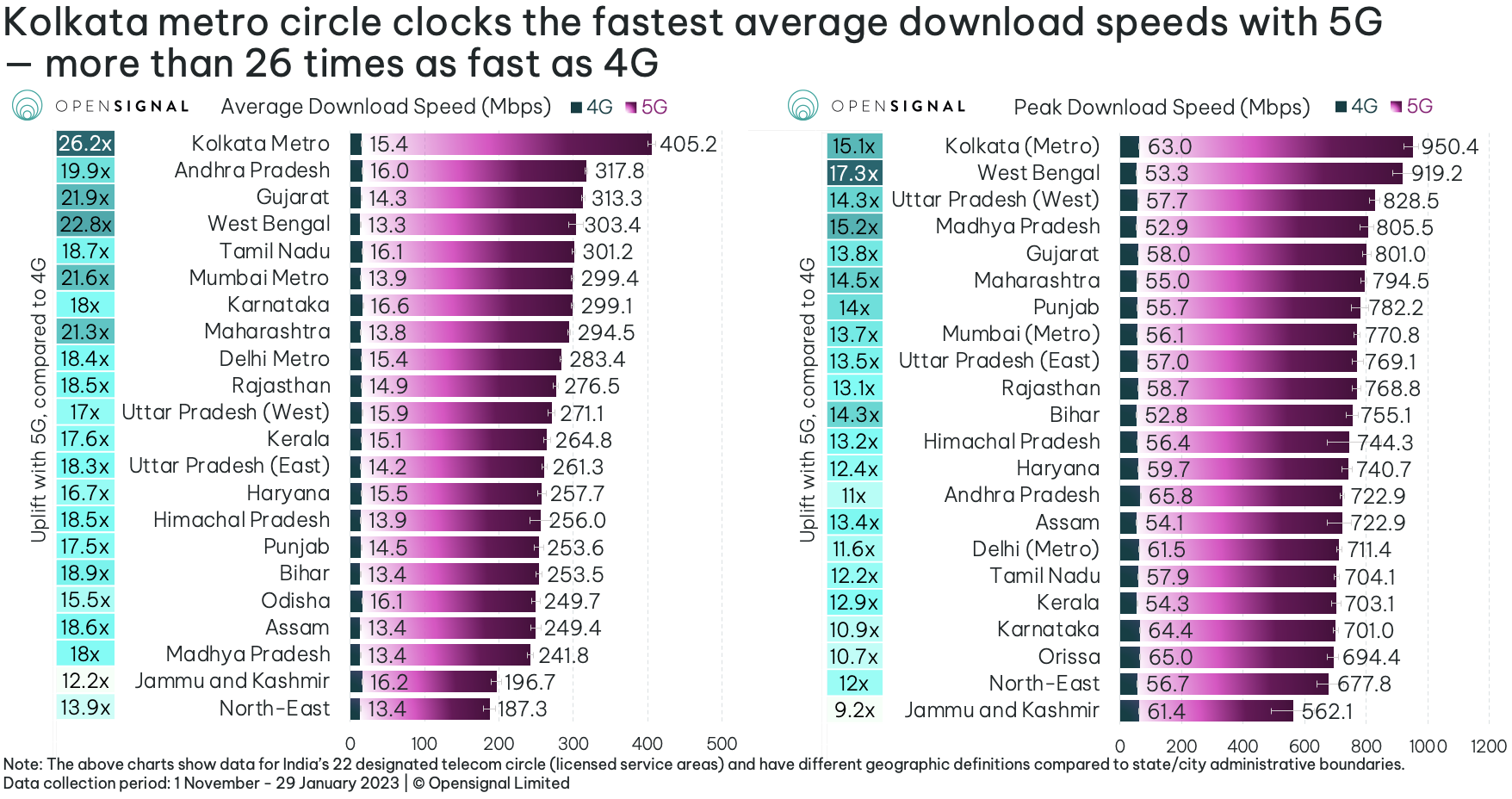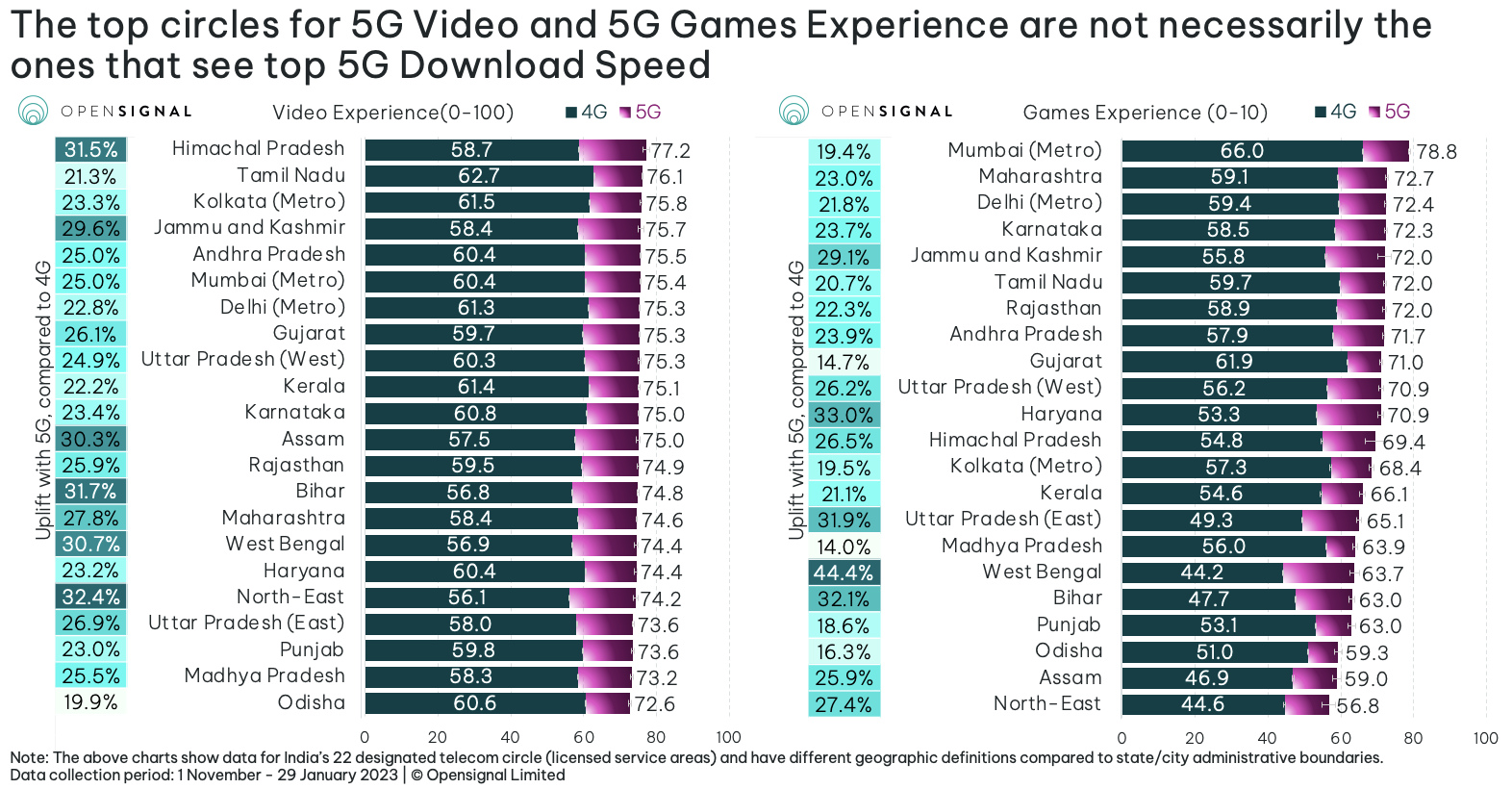India’s operators launched 5G in October 2022. Since then, Jio and Airtel have been putting significant efforts into expanding their 5G footprint across the country, with services now available across hundreds of locations. This Opensignal analysis examines the real-world 5G experience across 22 telecom circles of India and its major cities. There is a large uplift in users' experience with 5G compared to 4G. Across the circles, with 5G the average download speeds are between 12.2 and 26.2 times faster, Video Experience is 19.9-32.4% better, and Games Experience is 14-44.4% improved with 5G.

5G Availability varies significantly across different circles, Kolkata metro circle takes the lead
The Kolkata metro circle boasts the highest 5G Availability in India, with users spending an impressive 43.6% of the time with an active 5G connection, followed by Gujarat (30.6%) and Mumbai metro circle (30.5%). Worth noting that Gujarat is the only non-metro circle to make it to the top five. Meanwhile, the Delhi metro circle also demonstrates strong 5G Availability, with 5G users experiencing an active 5G connection for more than a quarter of the time.
Furthermore, 5G users in Bihar, Punjab, Rajasthan, Tamil Nadu, and Karnataka enjoy more than 20% 5G Availability, surpassing the 25% mark in Delhi. However, as we move down the list, there is a substantial drop in 5G Availability in more rural circles. Himachal Pradesh, along with Jammu and Kashmir exhibit the lowest scores, with users able to latch onto an active 5G connection for only 9.9% and 10.5% of the time, respectively.
5G Availability is based on actual user experience and reflects the proportion of time users with a 5G device and subscription have an active 5G connection. Unlike other methods, Opensignal’s approach measures the real experience of smartphone users in all environments, both indoors and outdoors, at any time of the day. 5G Availability, therefore, provides an accurate and comprehensive representation of the real experience of the 5G network.

Kolkata metro circle blazes ahead with 5G download speeds averaging above 400Mbps
The comparison between 5G and 4G download speeds is staggering. In fact, 5G speeds in India's telecom circles are 12.2 to 26.2 times faster than 4G. Kolkata Metro Circle once again takes the crown, with the biggest uplift in download speeds. West Bengal, Gujarat, Mumbai Metro Circle, and Maharashtra Circle are close behind with more than a 20-fold increase in download speed. As for the uplift in peak download speeds, West Bengal edges out with 5G speeds 17.3 times faster than 4G, followed by Madhya Pradesh (15.2x), Kolkata Metro (15.1x), and Maharashtra (14.5x) Circle.
When it comes to lightning-fast 5G download speeds, Kolkata Metro Circle is the undisputed champion, clocking in with an impressive 405.2Mbps average speed. But Kolkata isn't alone in the top ranks of India's fastest 5G speeds. Andhra Pradesh, Gujarat, West Bengal, and Tamil Nadu all boast download speeds exceeding 300Mbps.
Mumbai Metro Circle, Karnataka, and Maharashtra aren't far behind, surpassing Delhi Metro Circle's average of 283.4Mbps. Eight other circles enjoy an average 5G download speed of over 250Mbps, while three more boast speeds above 240Mbps. The North-East together with Jammu and Kashmir are the only two circles with 5G download speeds below 200Mbps.
But it's not just the average speeds that are impressive; 5G Peak Download speeds —— the average speed experienced by the top 2% of our users — are even higher. Kolkata Metro Circle and West Bengal lead the way with peak 5G speeds of 950.4Mbps and 919.2Mbps, respectively. Uttar Pradesh (West), Madhya Pradesh and Gujarat, also fare exceptionally well with Peak speeds of more than 800Mbps However, Delhi Metro Circle, Tamil Nadu, Kerala and Karnataka place in the lower half of the table with Peak speeds above 700Mbps. Meanwhile, Jammu and Kashmir is at the bottom of the table with an average 5G Peak Download speed of 562.1Mbps.

5G Video Experience rates as Very Good across all of India’s telecom circles
There is less variation across Indian telecom circles in 5G Video Experience than there is in 5G speeds. The quality of mobile video streaming over 5G networks rates as Very Good (68-78) in all 22 circles. A Very Good rating means that our users are, on average,able to stream video at 1080p or better with satisfactory loading times and little stalling.
In contrast, the 4G Video Experience rated as Good (58-68) in 20 circles and as Fair (48-58) in four circles: West Bengal, North-East, Bihar and Assam. Non-metro circles — Himachal Pradesh, Tamil Nadu, and Jammu and Kashmir are at the top of the table for 5G Video Experience along side Kolkata metro circle with scores in the 75.7-77.2 points range.
Measuring network speeds alone is not enough to understand the full spectrum of users’ mobile experience. For instance, Himachal Pradesh, which dominates the 5G Video Experience, or Jammu and Kashmir that places in the top half of the table, placed in the lower third for 5G Download Speed. Once again, this shows that download speed is just one of the multiple factors determining Video Experience. Latency plays an important role in ensuring quick load times, and a consistent throughput can help avoid buffering during video streaming. Peering links with content providers, intelligent caching systems, and other network optimization practices — for example, restricting video resolution or throttling a specific Content Delivery Network (CDN) such as YouTube — can also have an impact on smartphone users’ Video Experience.
Mumbai metro circle enjoys the best multiplayer mobile gaming experience with 5G
The Mumbai metro circle boasts a stunning 5G Games Experience score of 78.8 out of 100, placing it in the Good (75-85) category. Although Mumbai is currently the only circle to achieve this impressive rating, 14 other circles are holding their own in the Fair (65-75) category, while seven other circles are struggling in the Poor (40-65) category. This unfortunate group includes regions like West Bengal, Bihar, Punjab, Odisha, and North-East.
A Good 5G Games Experience means most users on 5G connections deem the experience acceptable. The gameplay experience is generally controllable, and the users receive immediate feedback between their actions and the outcomes in the game. Most users do not experience a delay between their actions and the game. And as we move down the ratings, users’ experience becomes less enjoyable, marred with increased delays and lack of controllability in gameplay.
All circles enjoyed a significantly better experience with 5G than with 4G. The 4G Games Experience across circles ranges from Poor to Fair, and the 5G Games Experience scores are between 14% and 44.4% better than those seen on 4G.
Tier 2 cities are experiencing some of the largest uplifts from 5G

The proportion of time Indian 5G users spend with an active 5G connection in India’s major cities ranges from 11.8% in Gorakhpur, Bihar to 44.8% in Howrah, West Bengal. Kolkata and Howrah are the only cities where 5G Availability surpassess the 40% mark. However, other cities with more than 30% 5G Availability include four cities from the state of Gujarat — Vadodara, Surat, Ahmedabad and Rajkot — two cities from the state of Rajasthan (Jodhpur and Jaipur), two cities from Jharkhand (Dhanbad and Ranchi), two from Maharashtra (Mumbai city and Solapur) while the remaining four are Asansol, Raipur, Ludhiana, and Lucknow. In total, 5G users see 5G Availability above 25% in 37 major Indian cities, with an additional 22 cities exceeding the 20% mark.

Opensignal Limited retains ownership of this insight including all intellectual property rights, data, content, graphs & analysis. Reports and insights produced by Opensignal Limited may not be quoted, reproduced, distributed, published for any commercial purpose (including use in advertisements or other promotional content) without prior written consent. Journalists are encouraged to quote information included in Opensignal reports and insights provided they include clear source attribution. For more information, contact [email protected].
